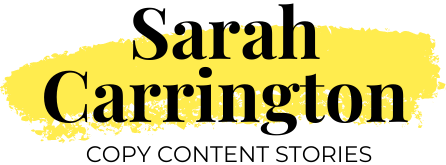The Star Wars rule that really matters - and how it can improve your copy.
I love Star Wars*.
I’ve loved it for more than forty years.
I didn’t want to love it. In my childhood world, Star Wars wasn’t for girls – despite having a heroine who could clearly handle herself (RIP Carrie Fisher), something that would become vanishingly rare as the 1980s progressed. I was reluctantly dragged along because my brothers wanted to see it.
But from the moment that text crawl started and the first bars of the score kicked in, I was hooked.
And even though my beloved Princess Leia pencil case, the Panini stickers, and the chewing gum swap cards eventually went the way of all things, I still feel the thrill every time I watch it.
I’m not alone. And I’m not just talking about the ageing fan boys and Disney bean-counters. Star Wars has attained almost mythical status in all kinds of writing circles because it is the almost perfect distillation of the Hero’s Journey – which makes it an ideal template for storytellers everywhere.
In his book, The Hero with a Thousand Faces (an inspiration for director George Lucas), John Campbell describes the common hero myth as follows:
“A hero ventures forth from the world of common day into a region of supernatural wonder: fabulous forces are there encountered and a decisive victory is won: the hero comes back from this mysterious adventure with the power to bestow boons on his fellow man.”
From obscure beginnings and personal tragedy, our hero seeks out an obscure McGuffin, finds a mentor, faces down deadly peril, discovers himself, saves the universe, and gets the girl (Spoiler: not really!) Somehow, Star Wars manages to incorporate heroic traditions found in Norse sagas, Grail romances, Japanese ronin and more. And with an added touch of Western cowboy swagger, it condenses all that into one glorious space opera.
It is all incredibly satisfying. (if not widely challenging)
And the same story arc can be found all over the place: myths, legends, novels, films, plays, ballets, operas and, yes, business writing.
In business writing, we try to position the vendor or even better, the customer, as the hero. They start out with a challenge to overcome; they find a seemingly magic solution in the vendor’s product; they wield it with great effect; they get to understand themselves better; and they boost their business.
——-
But almost perfect as it is, the story arc is not the most important copywriting lesson to take from Star Wars.
The most important lesson to take from Star Wars is the very far-from perfect script.
My love of Star Wars does not extend to much beyond The Empire Strikes Back, and it absolutely does not extend to the cod-profundity that the characters have to occasionally spout. It wobbles dangerously close to portentous, pompous nonsense.
I’m not alone in this view either. The actors agreed. Alec Guinness was notoriously doing it for the money, and Harrison Ford famously told his director:
“George, you can type this s**t, but you sure can’t say it.”**
And that’s it. That’s the Star Wars rule on copywriting that really matters.
You can write it. But if you can’t say it out loud, there’s a good chance that you need to write it in a different way.
Don’t believe me? Try this. Take your copy, find a quiet space, and read it out loud to yourself.
How does it sound? And importantly, how does it feel?
Do you sound recognisably human?
Do you recognise yourself or your client in the words you’re speaking?
Do you feel like a realistic version of yourself. More polished, more collected, and more professional maybe, but still you?
Do the words roll off the tongue in an easy speaking rhythm?
If the answer to any of these question is ‘no’, then it’s an indicator that your words are not working for you.
If you feel like an idiot (best avoided), if you can’t wait to stop reading, or if you find yourself re-reading the same phrase to get the meaning across, look again at what you’ve written. Vary the word length. Shorten your sentences. Choose more conversational words. Change the rhythm. Add punctuation where you naturally breathe. Take it out when you don’t. Make it easier to speak out loud, and you’ll make it easier to read on the screen.
In the end, all copywriters are B2H writers: business to human.
We write for people not Storm Troopers, Wookiees, or the assorted scum and villainy inhabiting the galaxy’s most wretched hives.
The Star Wars rule – Ford’s very human response to a very inhuman script – helps us all do that just a little bit better.
NOTES
*A New Hope, obviously.
**According to Peter Biskind’s Easy Riders, Raging Bulls. (Here in Switzerland).
If you’re interested, a great – and more feminist – counterpoint to the story of 1970s Hollywood, is The Invisible Woman, the series on Polly Platt from You Must Remember This.
And, finally, if you want to know more about non-Western traditions of storytelling, this episode of BBC Radio 4’s Screenshot on Indigenous film is excellent and eye opening.

